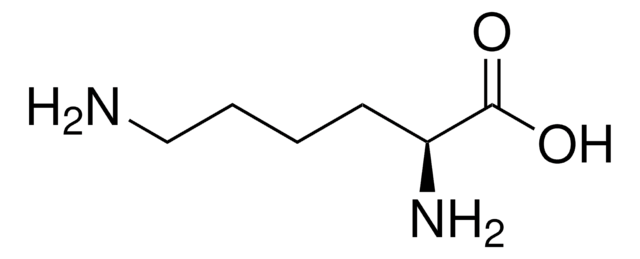L1884
L-Lysine acetate salt
≥98% (HPLC), suitable for ligand binding assays
Synonym(s):
(S)-2,6-Diaminohexanoic acid
Sign Into View Organizational & Contract Pricing
All Photos(4)
About This Item
Empirical Formula (Hill Notation):
C6H14N2O2 · C2H4O2
CAS Number:
Molecular Weight:
206.24
EC Number:
MDL number:
UNSPSC Code:
12352209
PubChem Substance ID:
NACRES:
NA.26
Recommended Products
Product Name
L-Lysine acetate salt, ≥98% (HPLC)
Quality Level
Assay
≥98% (HPLC)
form
powder
technique(s)
ligand binding assay: suitable
color
white
SMILES string
CC(O)=O.NCCCC[C@H](N)C(O)=O
InChI
1S/C6H14N2O2.C2H4O2/c7-4-2-1-3-5(8)6(9)10;1-2(3)4/h5H,1-4,7-8H2,(H,9,10);1H3,(H,3,4)/t5-;/m0./s1
InChI key
RRNJROHIFSLGRA-JEDNCBNOSA-N
Looking for similar products? Visit Product Comparison Guide
Biochem/physiol Actions
L-Lysine is an essential proteinogenic α amino acid used in a wide range of applications including as a supplement in cell culture media; a substrate of enzymes such as L-lysine oxidase (EC 1.4.3.14); a component of poly-lysine polymers; and a substrate for oxidation and glycation mechanism studies.
Storage Class Code
11 - Combustible Solids
WGK
WGK 2
Flash Point(F)
Not applicable
Flash Point(C)
Not applicable
Personal Protective Equipment
dust mask type N95 (US), Eyeshields, Gloves
Choose from one of the most recent versions:
Already Own This Product?
Find documentation for the products that you have recently purchased in the Document Library.
Customers Also Viewed
Stefan W Vetter et al.
Clinica chimica acta; international journal of clinical chemistry, 412(23-24), 2105-2116 (2011-08-13)
Serum protein glycation and formation of advanced glycation endproducts (AGE) correlates with diabetic complications. Highly AGE-modified albumin is frequently used to study the biochemical and cellular activities of AGE-proteins. However, moderately modified albumin samples are expected to be (patho)physiologically more
Xiu-Min Chen et al.
Journal of agricultural and food chemistry, 59(20), 11294-11303 (2011-09-23)
We investigated the antioxidant and anti-inflammatory activities of both crude and ultrafiltrated Maillard reaction (MR) products (MRPs) derived from sugar-amino acid MR models, comprising fructose (Fru), glucose (Glu) or ribose (Rib) reacted with glycine (Gly) or lysine (Lys), respectively. Crude
Gong Zhang et al.
Journal of agricultural and food chemistry, 59(22), 12037-12046 (2011-10-11)
A sensitive and reliable LC-(ESI)MS/MS method was developed and validated for the simultaneous analysis of five common advanced glycation endproducts (AGEs) after enzymatic digestion in raw and roasted almonds. AGEs included carboxymethyl-lysine (CML), carboxyethyl-lysine (CEL), pyralline (Pyr), argpyrimidine (Arg-p), and
Hideaki Endo et al.
Analytical and bioanalytical chemistry, 391(4), 1255-1261 (2008-02-01)
L-lysine (L-Lys) in living bodies is critical for metabolism; therefore, determination of its levels in food is important. Most enzymatic methods for L-Lys analysis are performed using L-lysine oxidase (LyOx), but commercially manufactured LyOx is generally not highly selective for
Daniel Gómez et al.
Biochimica et biophysica acta, 1764(10), 1577-1585 (2006-10-13)
The melanogenic marine bacterium M. mediterranea synthesizes marinocine, a protein with antibacterial activity. We cloned the gene coding for this protein and named it lodA [P. Lucas-Elío, P. Hernández, A. Sanchez-Amat, F. Solano, Purification and partial characterization of marinocine, a
Our team of scientists has experience in all areas of research including Life Science, Material Science, Chemical Synthesis, Chromatography, Analytical and many others.
Contact Technical Service





